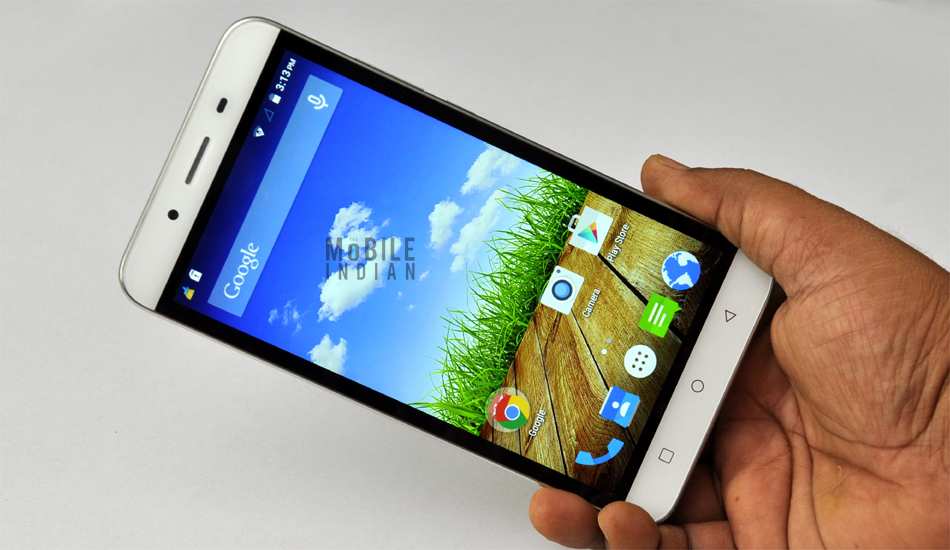Micromax started the Doodle series in the year 2013 with ‘big screen’ as the USP. The first phone with a 5.3 inch display was a rarity then. Now it has released the fourth installment in the series – Micromax Canvas Doodle 4 – which with a 6 inch display upholds the USP of the series.
I remember reviewing the second Doodle series smartphone, the Doodle 2, which was infact Micromax’s costliest phone at that time. But since Micromax has changed tactics and has come out with many series and Doodle seems to have dropped few notches from its scheme of things, atleast looking at the spec sheet of Doodle 4 suggests so.

At Rs 9,499, the Canvas Doodle 4 is no more the flaghship device of Micromax. Its specification sheet isn’t encouraging anyway, which I even cited in its First Cut.
Specs
The smartphone has a 6 inch display but with just qHD (540×960 pixels) resolution. But the screen has the Corning Gorilla Glass 3 protection. The Doodle 4 also has a decent 1.3 GHz quad core processor and 1 GB RAM combination which is expected to keep it smooth.
For storage, the phone offers 8 GB of internal storage and a micro SD card slot too. The Micromax Canvas Doodle 4 has an 8 megapixel auto focus rear camera and a 2 megapixel fixed focus front camera.
This Android Lollipop based smartphone has WiFi, Bluetooth 3.0, micro USB 2.0 port and GPS with AGPS support. There is a 3000 mAh non-removable battery in the phone which looks absolutely necessary for this mammoth. There are two micro SIM slots in the phone and it offers 3G connectivity.
It comes bundled with a charger, a headset and a flip cover.
Design
As I said earlier, the Doodle 4 has a huge 6 inch touchscreen. This mammoth feels a lot light for a 6 inch phone all thanks to its superb design. There are thin bezels on the right and left hand side of the display. This also helps in gripping the phone better. The matte finish back panel and curved side panels also aids gripping it better. The sides are protected by thin metal plates. The power button and volume keys are located on right hand side and are easily reachable.
As per Micromax, the Canvas Doodle 4’s 6 inch display has Corning Gorilla Glass 3 protection. However, during review it did get few scratches, though minor ones. The display’s viewing angle though was good, as one could expect from an IPS panel.
But my biggest disappointment was the display’s resolution. For a huge 6 inch display, these days everyone expects atleast HD resolution, even at the Rs 10,000 price point. That does not mean the qHD Resolution of Doodle 4’s display isn’t enough, but atleast HD resolution could have been much better. The lack of resolution though would pinch you only while watching HD movies and high end games.
There was also some issues with the touchscreen. In the first week, the display was simply erratic and didn’t respond to commands most of the time. Later the response of the screen improved significantly but still it never felt as smooth as we had expected.
Performance
With 1.3 GHz quad core processor and 1 GB RAM, the Doodle 4 was always expected to offer a smooth performance and it did as well. It did able to play Modern Combat 5 with ease and multi-tasking wasn’t an issue on Doodle 4 either.
Storage wise it isn’t any different than most of its competitors with 8 GB internal and 32 GB expandable storage slot. It also accepts external storage devices like pen drives (via OTG cable).
Now comes another big part, the cameras. The Doodle 4’s 8 megapixel rear camera does a pretty job in good lighting, capturing a lot of details. In low light, its performance goes down a bit but its still reasonable. The front 2 megapixel front camera is okay too. You could check out the camera samples here here.
The Doodle 4 has a 3000 mAh non-removable battery which was absolutely needed for such a huge phone. The battery is good enough for a day even with dual SIM and moderate usage. With continuous internet (WiFi or 3G), Bluetooth, single SIM, few minutes of browsing and gaming, the phone manages to stay alive for more than 12 hours which is decent. To give you some perspective, in one instance it consumed only about 10 per cent in playing a 45 minute offline-video with maximum brightness and with active WiFi connection.


